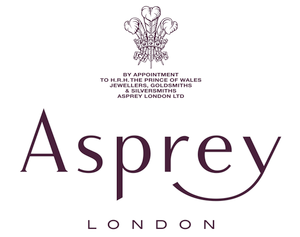British Heritage
Remember, Cherish, Learn.
beta
Asprey - Jewellers to the Gentry, since 1781
A Quintessential Embodiment of British Heritage.
Established in 1781, Asprey International Limited, historically known as Asprey & Garrard, has significantly contributed to British heritage, carving a unique place for itself as a designer, manufacturer, and retailer of luxury goods. Nestled on New Bond Street in London, Asprey's flagship store has become a symbol of British sophistication, luxury, and craftsmanship, while its extensive product range - encompassing jewellery, silverware, leather goods, timepieces, home goods, and books - serves as a testament to its versatility and innovation.
Founded by William Asprey as a silk printing enterprise in Mitcham, Surrey, the business soon burgeoned into a luxury emporium. The seeds for its legacy were sown in 1841 when Charles Asprey, William's elder son, partnered with a Bond Street stationer. In 1847, the Asprey family furthered its ambition by securing 167 New Bond Street, marking the beginning of its enduring association with the street that has become synonymous with luxury and opulence in London.
Throughout its existence, Asprey has championed 'articles of exclusive design and high quality', not only for personal adornment but also for home decor, thereby catering to 'people of refinement and discernment'. Its early specialty in crafting traditional leather dressing cases, suitable for the new age of railway travel, bore testimony to its dedication to quality and innovation. Although Asprey faced fierce competition, particularly from H.J. Cave & Sons, it proved its mettle by winning an honorable mention for its dressing cases at the International Exhibition of 1862.
Asprey's growth trajectory in the 20th century was remarkable. It acquired manufacturing facilities, recruited master craftsmen - including silversmiths, goldsmiths, jewellers, watchmakers, and leatherworkers - and expanded its product range to cater to a global clientele. Among its distinguished artisans was Ernest Betjeman, father of renowned poet John Betjeman.
Asprey's products became status symbols among the wealthy and the nobility, including American millionaire J. Pierpont Morgan and the Maharaja of Patiala. Its cigarette cases, travel clocks, safety razors, and automatic pencil sharpeners were particularly popular, demonstrating the company's ability to merge style with practicality.
Asprey's jewellery, inspired by the blooms found in English gardens and woodland flora, has held a distinctive place in its offerings. The Asprey cut, a 61-facet cushion cut created by master diamond cutter Gabi Tolkowsky, epitomises Asprey's commitment to perfection. These diamonds, ranging from 0.50 to 3 carats, are inscribed with the GIA certificate number and four distinctive 'A's, signifying the Asprey brand.
Asprey's silverware, both classic and contemporary, stand as elegant statements of its craftsmanship. From saltcellars fashioned to resemble cement mixers to children's items like tooth boxes and picture frames, the company's creativity has consistently shone.
Meanwhile, its leather goods have continued to evolve, with collections like the Beverly Hills collection marking milestones in Asprey's history. The men's collection includes wallets, cardholders, travel watch cases, briefcases, and backgammon boards, each exquisitely crafted.
Asprey has crafted numerous sporting trophies, including those for the Race To Dubai, the Dubai World Championship, the Arab Club Champions Cup, and the FA Cup, among others. It also ventured into book retailing in the early 1900s, and today, it offers a range of first and limited editions, many in their original or customised leather bindings.
Asprey's association with Polo dates back to the mid-1990s when it sponsored teams and created trophies for polo tournaments. Its product range for Polo, including boots, saddles, bridles, helmets, and mallets, underscores the company's commitment to diversification.
Asprey has also left its mark on the silver screen. It designed the Heart of the Ocean necklace for the 1997 blockbuster Titanic, and has appeared in numerous films, further expanding its reach and influence. In 2009, Asprey became the official jewellery sponsor of The Orange British Academy Film Awards and collaborated with Hollywood stars Angelina Jolie and Brad Pitt to create the Asprey's Protector Collection.
Asprey's long-standing association with the British monarchy bolsters its stature in the world of luxury goods. Queen Victoria granted it a Royal Warrant in 1862, followed by the Prince of Wales, later King Edward VII. For Queen Elizabeth II's coronation in 1953, Asprey unveiled the Coronation Year Gold Collection, a testament to its commitment to the royal family.
Internationally, Asprey continues to flourish as a luxury goods house. A survey by the Luxury Institute's 2012 Luxury Brand Status Index ranked Asprey among the top two international fine jewellery brands, underscoring its global reputation for delivering true luxury. Asprey's unwavering dedication to providing exceptional products and unmatched customer service is encapsulated in its motto, "It Can be Done".
From its beginnings in Mitcham, Surrey, to its status as a globally recognised luxury brand, Asprey has etched its legacy in British heritage. Its story, woven from threads of innovation, craftsmanship, and luxury, speaks volumes about the indomitable spirit of British entrepreneurship. In an age of ephemeral trends and transient fashion, Asprey stands steadfast, a testament to enduring quality and timeless style. As it continues to evolve and adapt to the changing times, it remains, at its heart, quintessentially British.
A Historical Overview
Founded by William Asprey as a silk printing enterprise in Mitcham, Surrey, the business soon burgeoned into a luxury emporium. The seeds for its legacy were sown in 1841 when Charles Asprey, William's elder son, partnered with a Bond Street stationer. In 1847, the Asprey family furthered its ambition by securing 167 New Bond Street, marking the beginning of its enduring association with the street that has become synonymous with luxury and opulence in London.
Throughout its existence, Asprey has championed 'articles of exclusive design and high quality', not only for personal adornment but also for home decor, thereby catering to 'people of refinement and discernment'. Its early specialty in crafting traditional leather dressing cases, suitable for the new age of railway travel, bore testimony to its dedication to quality and innovation. Although Asprey faced fierce competition, particularly from H.J. Cave & Sons, it proved its mettle by winning an honorable mention for its dressing cases at the International Exhibition of 1862.
Growth and Innovation in the 20th Century
Asprey's growth trajectory in the 20th century was remarkable. It acquired manufacturing facilities, recruited master craftsmen - including silversmiths, goldsmiths, jewellers, watchmakers, and leatherworkers - and expanded its product range to cater to a global clientele. Among its distinguished artisans was Ernest Betjeman, father of renowned poet John Betjeman.
Asprey's products became status symbols among the wealthy and the nobility, including American millionaire J. Pierpont Morgan and the Maharaja of Patiala. Its cigarette cases, travel clocks, safety razors, and automatic pencil sharpeners were particularly popular, demonstrating the company's ability to merge style with practicality.
Jewellery, Silver, and Leather: The Trinity of Asprey's Craftsmanship
Asprey's jewellery, inspired by the blooms found in English gardens and woodland flora, has held a distinctive place in its offerings. The Asprey cut, a 61-facet cushion cut created by master diamond cutter Gabi Tolkowsky, epitomises Asprey's commitment to perfection. These diamonds, ranging from 0.50 to 3 carats, are inscribed with the GIA certificate number and four distinctive 'A's, signifying the Asprey brand.
Asprey's silverware, both classic and contemporary, stand as elegant statements of its craftsmanship. From saltcellars fashioned to resemble cement mixers to children's items like tooth boxes and picture frames, the company's creativity has consistently shone.
Meanwhile, its leather goods have continued to evolve, with collections like the Beverly Hills collection marking milestones in Asprey's history. The men's collection includes wallets, cardholders, travel watch cases, briefcases, and backgammon boards, each exquisitely crafted.
Trophies, Books, and Beyond
Asprey has crafted numerous sporting trophies, including those for the Race To Dubai, the Dubai World Championship, the Arab Club Champions Cup, and the FA Cup, among others. It also ventured into book retailing in the early 1900s, and today, it offers a range of first and limited editions, many in their original or customised leather bindings.
Polo and Film: Expanding the Asprey Legacy
Asprey's association with Polo dates back to the mid-1990s when it sponsored teams and created trophies for polo tournaments. Its product range for Polo, including boots, saddles, bridles, helmets, and mallets, underscores the company's commitment to diversification.
Asprey has also left its mark on the silver screen. It designed the Heart of the Ocean necklace for the 1997 blockbuster Titanic, and has appeared in numerous films, further expanding its reach and influence. In 2009, Asprey became the official jewellery sponsor of The Orange British Academy Film Awards and collaborated with Hollywood stars Angelina Jolie and Brad Pitt to create the Asprey's Protector Collection.
Royal Patronage and International Success
Asprey's long-standing association with the British monarchy bolsters its stature in the world of luxury goods. Queen Victoria granted it a Royal Warrant in 1862, followed by the Prince of Wales, later King Edward VII. For Queen Elizabeth II's coronation in 1953, Asprey unveiled the Coronation Year Gold Collection, a testament to its commitment to the royal family.
Internationally, Asprey continues to flourish as a luxury goods house. A survey by the Luxury Institute's 2012 Luxury Brand Status Index ranked Asprey among the top two international fine jewellery brands, underscoring its global reputation for delivering true luxury. Asprey's unwavering dedication to providing exceptional products and unmatched customer service is encapsulated in its motto, "It Can be Done".
Conclusion
From its beginnings in Mitcham, Surrey, to its status as a globally recognised luxury brand, Asprey has etched its legacy in British heritage. Its story, woven from threads of innovation, craftsmanship, and luxury, speaks volumes about the indomitable spirit of British entrepreneurship. In an age of ephemeral trends and transient fashion, Asprey stands steadfast, a testament to enduring quality and timeless style. As it continues to evolve and adapt to the changing times, it remains, at its heart, quintessentially British.
- Aspreyen.wikipedia.org







